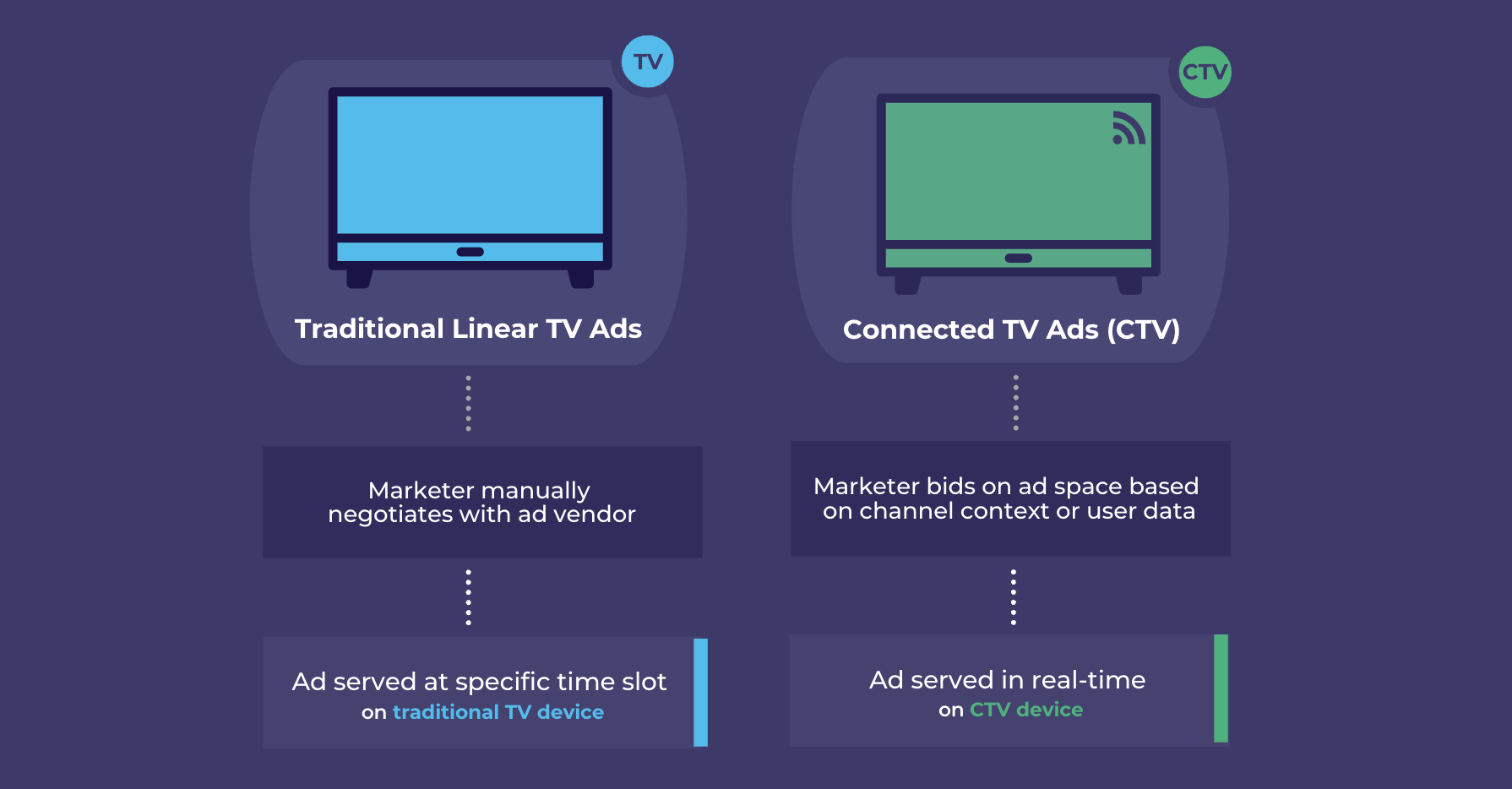Advantages of TV Advertising
| Pathlabs Marketing |
| May 31, 2023 |
In today's evolving advertising landscape, television advertising holds a prominent position offering brands unique opportunities to connect with their target audiences.
In this blog, we will explore the advantages of television advertising, considering both traditional TV methods and the rise of connected TV (CTV). Understanding the benefits and limitations of this dynamic medium will empower advertisers to make informed decisions and effectively leverage television advertising to achieve their marketing goals.
What is Television Advertising?
Television advertising encompasses the promotion of products or services through commercials aired on television networks or channels. It provides brands a platform to showcase their offerings to a vast audience and engage viewers through visually captivating storytelling.
This definition explicitly encompasses linear television, the traditional way of accessing television content. Audiences access linear TV content through a subscription to cable or a free-to-air signal. As a result, linear TV content relies on the broadcaster's schedule.
Marketers commonly place traditional TV ads via manual negotiation with the ad inventory vendor. To do so, they can usually visit the websites of the channels and networks that interest them and contact the sales team.
“Although linear television advertising is frequently considered a ‘traditional’ and ‘older’ method, it can still be incredibly effective at building brand awareness.”
What is Connected Television Advertising?
Connected television advertising is delivering targeted advertisements to viewers on connected TV platforms. It involves using advertising techniques and technologies to reach audiences who are streaming content on internet-connected televisions, smart TVs, streaming media players, or other CTV devices.
It's essential to differentiate CTV from OTT. CTV refers to a specific device connected to the internet. Over-the-top refers to the means of how the ad is served, over the internet. OTT services allow for the delivery of ad content on CTV devices, as well as mobile, tablet, and desktop devices.
“CTV offers more on-demand viewing content, accessible anytime and anywhere. While linear TV is more limited to physical locations and a set airing schedule.”
The Advantages of TV Advertising
Television Ads Reach a Wider Demographic
TV and CTV ads reach a wider demographic by leveraging the broad viewership of television and the accessibility of internet-connected devices.
With CTV advertising, campaigns use programmatic software that allows real-time predictive targeting, which helps place ads in the most optimal locations.
Marketers leveraging contextual advertising benefit from CTV advertising because many TV channels and CTV platforms are topic based. Therefore, they can field ads in locations that resonate with the ad content, such as a dog food commercial on the nature channel or an insurance ad for Spanish Speakers on the Telemundo streaming platform.
Viewers Spend a Lot of Time Watching TV
According to a 2022 study, 123.8 million homes in the U.S. have a television (Statista). U.S. citizens spend a substantial amount of time watching TV, making it an attractive medium for reaching and engaging potential customers.
TV Attracts Loyal Viewers
“We all have a TV show we love and tune into often. Brands can take advantage of this: if they know that their target audience has a genre or show they enjoy watching at a certain time, they can try and place their content in these channel time slots.”
TV Ads Build Trust
Despite the increasing accessibility to TV ads via CTV, these ads are still not cheap. Therefore, when a brand succeeds at placing a TV ad, this serves as a point of legitimacy to the audience, validating the brand's service, size, and ability. This, of course, is contingent on the quality and pertinence of the content.
TV Ads and Online Strategies Can Work Together
Television advertising and online strategies are not mutually exclusive; they can synergize to amplify brand impact. Advertisers can use CTV campaigns as an effective tool to run alongside other tactics, such as a Meta prospecting campaign, Google Ads search campaign, display retargeting campaign, etc. An integrated approach strengthens the overall marketing strategy. It maximizes the reach and effectiveness of the brand message.
Cross-device attribution and household extensions can also be key benefits of CTV, contrary to the belief that they lack attribution capabilities. In reality, CTV platforms offer robust tracking mechanisms that allow marketers to analyze the customer journey path, providing valuable insights into conversions and enabling effective attribution of advertising efforts.
TV Commercials Offer Multi-Sensory Appeal
TV can stimulate our vision, hearing, minds, and hearts. Whether watching a touching movie or cheering on our favorite team as they make a touchdown, marketers can produce stellar content that caters to these senses.
The Disadvantages of TV Advertising
Viewers Sometimes Become Numb to TV Ads
Television ads interrupt shows and can be irrelevant, ultimately serving as a prompt to look at one's phone or take a bathroom break. This sad reality can make many marketers feel like they wasted their TV ad spend.
That being said, TV advertising remains a valuable medium for brand building and reaching your audience, despite some viewers becoming disengaged. With effective creative strategies and targeted placements, advertisers can leverage the power of television to create emotional connections, generate brand awareness, and drive desired outcomes.
Television Ads Are More Effective with Repetition
Linear TV ads, despite their wide reach and impact, face significant challenges when it comes to repetition. These challenges arise from fixed airing schedules, high costs, and limited time slots. Due to these constraints, placing linear TV ads simultaneously or repeatedly over multiple days or weeks becomes an uphill battle.
In contrast, CTV ads offer a game-changing advantage: retargeting and personalization. Through the use of device graphs, advertisers can identify users who have previously engaged with their domain. This data allows advertisers to retarget these specific users with CTV ads in future campaigns.
By leveraging retargeting and personalization, CTV ads enable advertisers to engage the same users repeatedly. This repetition amplifies the impact of the ad message and increases the likelihood of conversion. It provides an opportunity to reinforce brand awareness, drive engagement, and ultimately achieve campaign objectives more effectively.
TV Ads Are Difficult to Change on the Fly
A drawback of TV ads is their limited flexibility in making real-time changes. Once a marketer sets the ad, quickly modifying it is challenging, making it less adaptable to dynamic marketing needs.
Should Your Brand Invest in TV Advertising?
Teams should consider investing in traditional linear TV advertising when they have a broad target audience, need wide reach, and aim to generate high-scale awareness. Having the budget, time, and strong contacts with TV ad space vendors is also important.
On the other hand, using CTV advertising allows advertisers to expand their reach beyond traditional linear TV and tap into the growing audience of streaming service viewers. Compared to linear TV, connected TV ads increase total time with the consumer by 447% (KeynesDigital, 2023).
This extended reach enhances brand awareness and engagement among target audiences, ultimately leading to improved return on investment (ROI) for advertising efforts. By leveraging CTV advertising, brands can effectively connect with viewers who have shifted to streaming platforms like Hulu, and Amazon Prime Video, thereby building stronger audience connections and maximizing the impact of their advertising campaigns.
The Future of Television Advertising
“Looking into the future of television advertising, we anticipate that CTV advertising will continue to be very attractive for advertisers.”
As we peer into the future of television advertising, it becomes evident that CTV advertising will continue to entice advertisers with its numerous benefits. The gradual decline of traditional linear TV advertising is inevitable, primarily due to the increasing prominence of CTV devices and OTT content. This newer advertising option provides users with greater freedom and flexibility in choosing what they watch, surpassing the limitations of rigid schedules and excessive commercial breaks associated with linear TV.
The expanding prevalence of CTV devices and OTT content also foretells the emergence of more streaming platforms featuring sliding-scale subscription models, like Netflix's Basic with Ads. With this model, users can access content for $6.99 per month, with occasional ad interruptions, compared to the ad-free subscription priced between $15 and $20 per month. As ad-based subscriptions grow in number, marketers gain increased opportunities to position their content directly in front of their target audience.
While Netflix has been a dominant force in the streaming industry for years, its delayed adoption of ad-based subscriptions allowed other platforms to gain a foothold by catering to price-sensitive consumers. By being late to embrace this trend, Netflix missed out on potential subscribers seeking more affordable options.
Additionally, the high minimum fees for advertisers eliminates the opportunity for smaller and medium-sized advertisers to take advantage of Netflix advertising. In contrast, streaming platforms offering lower price points for advertisers attract those prioritizing cost-effectiveness, expanding their user base, and allowing marketers to reach a wider range of target audiences directly.
Regardless, in light of these developments, we are seeing a trend of advertising budget transfers from traditional linear TV advertising to CTV, as the latter offers superior targeting capabilities and aligns better with the evolving preferences of viewers.
In Conclusion
Television advertising and connected television (CTV) advertising offer unique opportunities for marketers. Traditional television advertising continues to reach a wide demographic and captivate viewers with its multi-sensory appeal. In contrast, CTV advertising leverages the power of internet connectivity and programmatic capabilities to deliver targeted messages on internet-connected devices. As technology evolves, brands are integrating both approaches to maximize their reach and impact.
Whether through traditional TV or CTV, investing in television advertising can be a strategic move for brands looking to engage audiences, build trust, and drive results. By staying informed about industry trends and consumer behavior, brands can navigate the ever-changing landscape of TV and CTV advertising to stay ahead of the competition and effectively connect with their target audience.
















